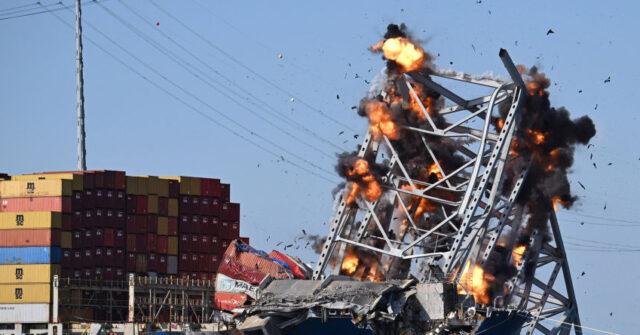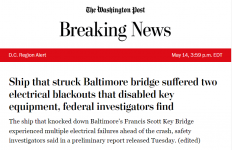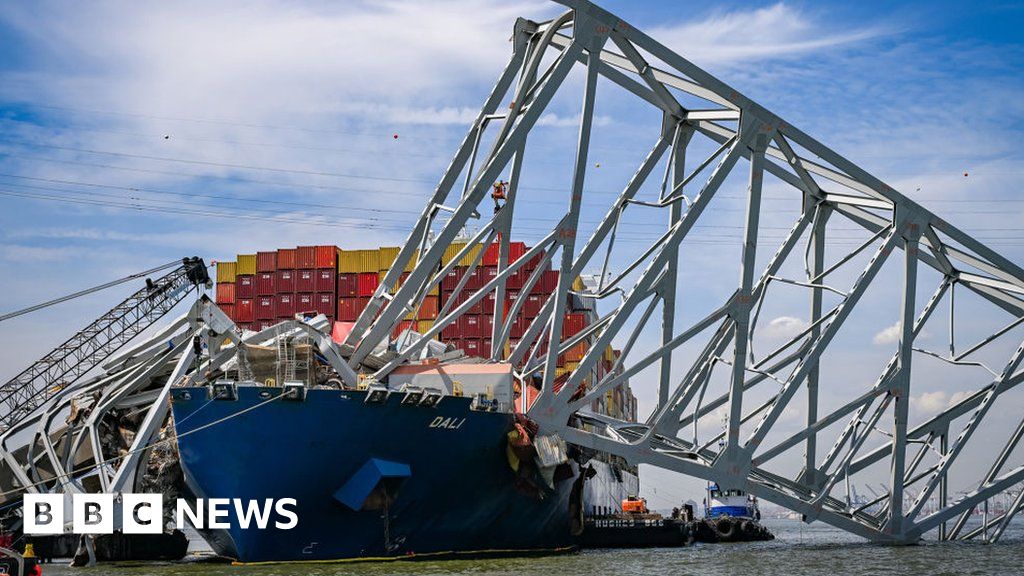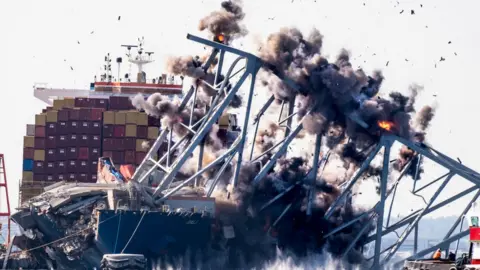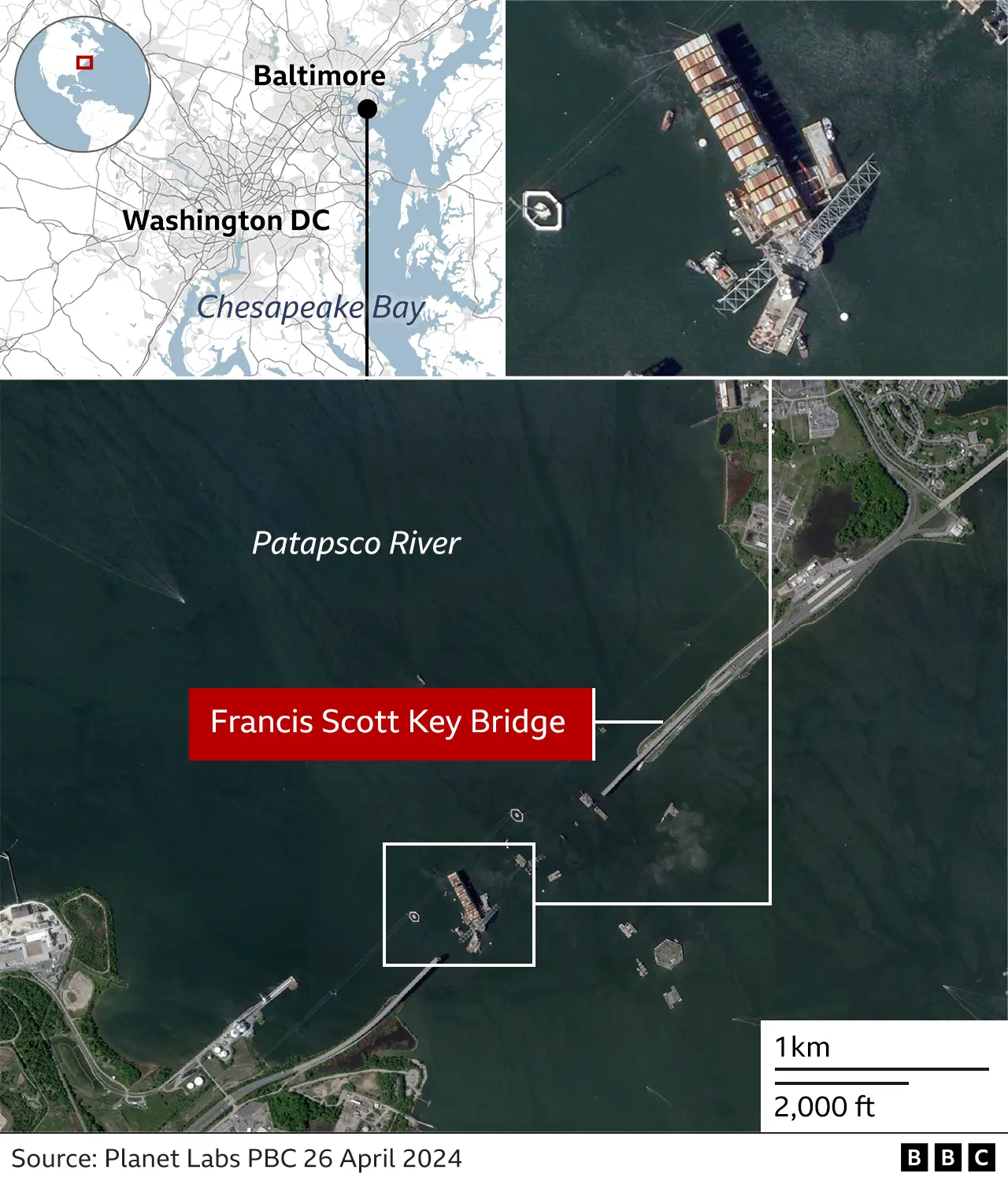Morale is low for the Dali's crew members, who are stranded on board by the ongoing investigation into the tragedy.

www.bbc.com
Crew trapped on Baltimore ship, seven weeks after bridge collapse
14 hours ago
By Bernd Debusmann Jr,BBC News, Washington
Getty Images
The crew of the Dali remained on-board even as explosives were used to destroy part of the Key Bridge on its hull
As a controlled explosion rocked the Dali on Monday, nearly two dozen sailors remained on board, below deck in the massive ship's hull.
The simultaneous blasts sent pieces of Baltimore's once iconic Francis Scott Key Bridge into the dark waters of Maryland's Patapsco River, seven weeks after its collapse left six people on the bridge dead and the Dali marooned.
Authorities - and the crew - hope that the demolition will mark the beginning of the end of a long process that has left the 21 men on board trapped and cut off from the world, thousands of miles from their homes.
But for now, it remains unclear when they will be able to return home.
The Dali - a 948ft (289m) container ship - was at the start of a 27-day journey from Baltimore to Sri Lanka when it struck the Francis Scott Key Bridge, sending thousands of tonnes of steel and cement into the Patapsco. It left the ship stranded under a massive expanse of shredded metal.
A preliminary NTSB report found that two electrical blackouts disabled equipment ahead of the incident, and noted that the ship lost power twice in the 10 hours leading up to the crash.
The crew, made up of 20 Indians and a Sri Lankan national, has been unable to disembark because of visa restrictions, a lack of required shore passes and parallel ongoing investigations by the National Transportation Safety Board (NTSB) and FBI.
On Monday, the crew remained on board even as authorities used small explosive charges to deliberately "cut" an expanse of the bridge lying on the ship's bow.
Ahead of the controlled demolition, US Coast Guard Admiral Shannon Gilreath said that the crew would remain below deck with a fire crew at the ready.
"They're part of the ship. They are necessary to keep the ship staffed and operational," Adm Gilreath said. "They're the best responders on board the ship themselves."
While the ship is likely to be re-floated this week, it remains unclear when it will be able to make the 2 nautical mile (3.7km) journey to port.
'A sad situation'
Among those who have been in touch with the crew is Joshua Messick, executive director of the Baltimore International Seafarers' Center, a non-profit organisation that works to protect the rights of mariners.
According to Mr Messick, the crew has been left largely without communication with the outside world for "a couple of weeks" after their mobile phones were confiscated by the FBI as part of the investigation.
Watch: Baltimore bridge demolished with controlled explosions
"They can't do any online banking. They can't pay their bills at home. They don't have any of their data or anyone's contact information, so they're really isolated right now," Mr Messick said. "They just can't reach out to the folks they need to, or even look at pictures of their children before they go to sleep. It's really a sad situation."
The plight of the sailors also attracted the attention of the two unions representing them, the Singapore Maritime Officers' Union and the Singapore Organisation of Seamen.
In a joint statement on 11 May, the unions said that "morale has understandably dipped", driven by "unfounded fear of personal criminal liability" and emotional distress.
The statement also called for the "swift return" of the crews' phones, noting that losing communication with family members is "causing significant hardship for crew members with young children at home."
Dave Heindel, the president of the Seafarers International Union, said that "however long the investigation takes, the crew's rights and welfare should not be infringed upon".
"We call on the authorities to be mindful that seafarers utilise mobile devices to conduct personal business for bill payments, and, more important, transfer money to their home country to sustain families," he said. "Crew members are becoming demoralised without the basic tools we all take for granted."
Andrew Middleton, who runs Apostleship of Sea - a programme that ministers to ships coming through Baltimore - told the BBC he visited the sailors two weeks ago and found them in "good spirits" despite constant worries.
"Once we broke the ice and got everyone to say their name and what part of India they were from, and talk about if they were married or had children, we got the ball rolling," he said. "They were willing to kind of poke fun at one another a little bit.... we did our best to get them laughing and joking, hopefully to take their mind off things for even a few minutes."
Next steps
For the time being, the crew has been given SIM cards and temporary mobile phones without data included, according to Mr Messick.
They also received care packages from various community groups and private individuals, which in recent weeks have included batches of Indian snacks and handmade quilts.
The BBC has reached out to the ''unified command'' overseeing the government's response to Dali and the bridge collapse for clarity on when the sailors might be able to leave the ship and, eventually, be repatriated.
Darrel Wilson, a spokesperson for Synergy Marine, the Dali's Singapore-based management company, told the BBC that the crew is "holding up well" and that company representatives dispatched to Baltimore have been "checking on them constantly, from day one."
"All their needs are being met to the best of our ability," Mr Wilson said, adding that shipments of catered Indian food have been sent aboard to allow the cooks to rest.
Various religious representatives, including Hindu priests, have been providing services and emotional support to those aboard.
"It's small things to us," he said. "But those are big morale boosters."
Mr Wilson, however, said he was unable to provide a timeline for the crew to disembark, noting that - in addition to the investigations - "nobody knows the ship better than they do" and that they are integral for it to function.
Mr Messick said he expects to be able to board the ship to provide "emotional support" as soon as it is moved out of the shipping channel.
After that, he believes that small groups of sailors - perhaps five at a time - will be eligible for shore passes, albeit with heavy restrictions on their movements.
They will, for example, likely be required to have an escort for the duration of their time on shore.
"I'm trying to find out what the crew wants to do. I don't want to take them to a baseball game if they are going to be bored," he said. "So I've reached out to a local cricket club to see if they can organise a match."
Some crew members, such as the ship's captain, expressed an interest in being "somewhere contemplative, in nature", Mr Messick said.
"We're just trying to help them breathe a bit," he said. "They've been stuck on board this whole time. They need to enjoy a little more of the freedom that we enjoy every day."



